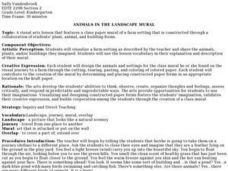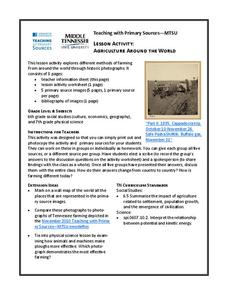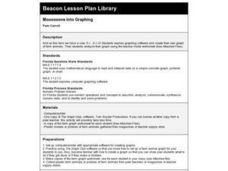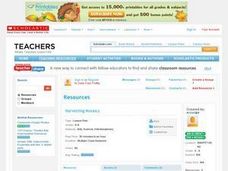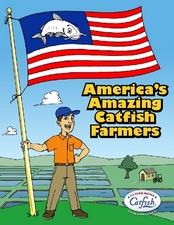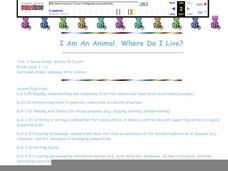Curated OER
Animals in the Landscape Mural
Students design animals and settings for the class mural they find on the visual journey to a farm through the cutting, tearing, pasting, and coloring of colored paper. Visualizing and designing constructed paper forms fosters Students'...
Curated OER
Agriculture Around the World
Students explore various kinds of farming methods around the world. In this history activity, students view pictures of farming methods, then compare and contrast them in a class discussion with the methods of farming that are used...
Curated OER
Moooooove into Graphing
First graders explore graphing software and create their own graph of farm animals. Then students analyze their graph using the teacher made worksheet which is imbedded in this lesson plan. Great lesson!
Curated OER
Harvesting Mosaics
Middle schoolers use pieces of farm pictures to investigate the elements of art. In this farm art lesson, students use pieces of pictures to create an original artwork. Middle schoolers use the Internet to find images. ...
Curated OER
English Exercises
In this recognizing animal names reading worksheet, 1st graders name 10 animals. A word bank of the animal names is provided and students must write the name to match each animal picture.
Down Syndrome Possibilities
Down Syndrome: Lesson Plan
You don't usually find lessons written just for learners with Down syndrome, so this is a true jewel. Kindergartners will explore farm animal sounds and identification as they sing the song, "Down on Grandpa's Farm." They sing the song,...
August House
The Pig Who Went Home on Sunday
Turn your classroom into a pig sty with a instructional activity based on the Appalachian folktale The Pig Who Went Home on Sunday. Similar to the story of The Three Little Pigs, the folktale tells a story of four pigs who leave...
Curated OER
Holistic Lesson Plan 4
Students identify farm animals after receiving visual stimuli and a verbal prompt. They apply appropriate social language into her vocabulary base through group interaction with peers. They mimic a physical action when given a model.
Curated OER
Farming Number 6
In this environment worksheet, students identify and explain the importance of water and farming. They identify the differences between food items and whether they are a fruit, vegetable, or animal. Students also respond to 5 yes/no...
Curated OER
Wild Or Domestic?
Students discuss differences between wild and domestic animals. They list animals on chart paper, and then cut out pictures from magazines to create large collage showing wild and domestic animals.
Curated OER
Dictionaries
Introduce your budding readers to the dictionary. They read a brief introduction on dictionary features, observing pictures and examples of one-syllable words they could find in a dictionary. Using the word list, they determine which...
Curated OER
Giving Thanks for Food and Farms
Sarah Stewart’s The Gardener and Food from Farms by Nancy Dickmann display the importance of community farms. After reading these short picture books, class members draw connections between farms and the food we eat each day. As a...
Curated OER
Life on a Farm
Students take a field trip to a farm or observe pictures of farms and animals in the classroom. They paint a mural of a farm setting with animals. They practice phonetic skills with farm stories and songs. They explain how milk becomes...
Curated OER
Down on the Farm
Students are introduced to a map of an Illinois farm. They determine whether the map is of the past, present, or future by looking at features on the map. They also use the map to make a three-dimensional model.
Curated OER
Main Idea
In this main idea worksheet, students complete the sentences by choosing the best main idea based on the pictures given. Students complete 8 problems.
Curated OER
Farms And Cities
Students differentiate the differences of living on a farm or in a city. They do this with the use of coloring pictures and have group discussion about each picture to identify characteristics and identify where the picture is from. The...
Curated OER
Stormy Weather
Fifth graders demonstrate their knowledge for how animals survive in natural environments when a storm occurs. In this science/writing lesson, 5th graders engage in a listening activity with the teacher. Additionally, students write a...
Curated OER
Catfish Coloring Book
In this catfish coloring book activity, students read information about catfish and color pictures in a twenty-page coloring book. Final page contains recipes.
Curated OER
I Am An Animal: Where Do I Live?
Students make an alphabet booklet using the computer to find pictures and facts about farm animals, zoo animals and pets. They write facts about the animals: where they live, what they eat, their coloring, etc.
Curated OER
LISTENING TO DIRECTIONS
Students view farm objects or products made from farm animals and follow the oral instructions given by the teacher. They are given worksheets, there are three sets of directions for the one worksheet. Students worksheets have everything...
Curated OER
Have You the Time of Day?
Students read a story about a day in the life of a farmer. They practice reading and writing time. They write a picture story about his or her day. They draw clock faces showing what time of day each of the events occurred.
Curated OER
Onomatopoeia Poems
Students write onomatopoeia poems. In this creative writing activity, students listen to a picture book that introduces the concept of onomatopoeia. Students create their own list of words and write a short poem using onomatopoeia.
Curated OER
Lesson Plan One: Points, Lines, Rays
Fifth graders explore basic geometric terms. Pupils draw a physical picture of a scene that illustrates at least five geometric terms. Partners exchange drawings and locate the illustration of geometric terms in the drawing.
Curated OER
Where is Agriculture?
Students explore agriculture. In this agriculture lesson, students read "Where is Agriculture?" and discuss all the things that come from agriculture. Students discuss what they need to survive and give examples of agricultural products...


